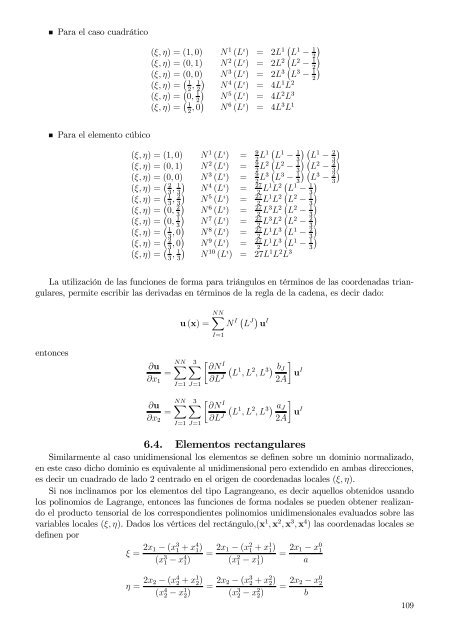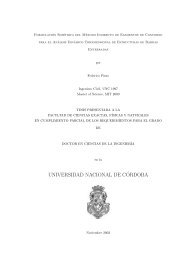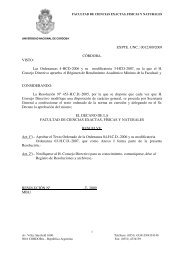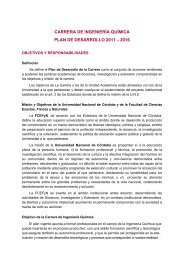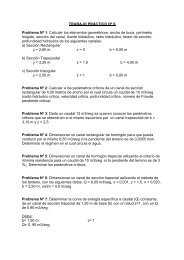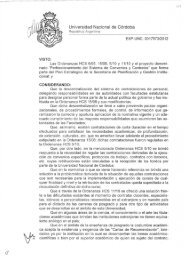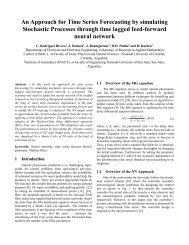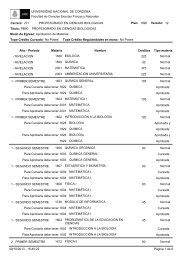Capítulo 1 Métodos de residuos ponderados Funciones de prueba ...
Capítulo 1 Métodos de residuos ponderados Funciones de prueba ...
Capítulo 1 Métodos de residuos ponderados Funciones de prueba ...
You also want an ePaper? Increase the reach of your titles
YUMPU automatically turns print PDFs into web optimized ePapers that Google loves.
Para el caso cuadrático<br />
(ξ, η) = (1, 0) N 1 (L ı ) = 2L ( )<br />
1 L 1 − 1 2<br />
(ξ, η) = (0, 1) N 2 (L ı ) = 2L ( )<br />
2 L 2 − 1 2<br />
(ξ, η) = (0, 0) N 3 (L ı ) = 2L ( )<br />
3 L 3 − 1 2<br />
(ξ, η) = ( 1<br />
, )<br />
1 N 4 (L ı ) = 4L 1 L 2<br />
2 2<br />
(ξ, η) = ( )<br />
0, 1 N 5 (L ı ) = 4L 2 L 3<br />
2<br />
(ξ, η) = ( 1<br />
, 0) N 6 (L ı ) = 4L 3 L 1<br />
2<br />
Para el elemento cúbico<br />
(ξ, η) = (1, 0) N 1 (L ı ) = ( ( )<br />
9<br />
2 L1 L 1 − 3) 1 L 1 − 2 3<br />
(ξ, η) = (0, 1) N 2 (L ı ) = ( ( )<br />
9<br />
2 L2 L 2 − 3) 1 L 2 − 2 3<br />
(ξ, η) = (0, 0) N 3 (L ı ) = ( ( )<br />
9<br />
2 L3 L 3 − 3) 1 L 3 − 2 3<br />
(ξ, η) = ( 2<br />
, )<br />
1 N 4 (L ı ) = 27 3 3<br />
2 L1 L ( )<br />
2 L 1 − 1 3<br />
(ξ, η) = ( 1<br />
, )<br />
2 N 5 (L ı ) = 27 3 3<br />
2 L1 L ( )<br />
2 L 2 − 1 3<br />
(ξ, η) = ( )<br />
0, 2 N 6 (L ı ) = 27 3<br />
2 L3 L ( )<br />
2 L 2 − 1 3<br />
(ξ, η) = ( )<br />
0, 1 N 7 (L ı ) = 27 3<br />
2 L3 L ( )<br />
2 L 2 − 2 3<br />
(ξ, η) = ( 1<br />
3 , 0) N 8 (L ı ) = 27 2 L1 L ( )<br />
3 L 1 − 2 3<br />
(ξ, η) = ( 2<br />
, 0) N 9 (L ı ) = 27 3 2 L1 L ( )<br />
3 L 1 − 1 3<br />
(ξ, η) = ( 1<br />
, )<br />
1 N 10 (L ı ) = 27L 1 L 2 L 3<br />
3 3<br />
La utilización <strong>de</strong> las funciones <strong>de</strong> forma para triángulos en términos <strong>de</strong> las coor<strong>de</strong>nadas triangulares,<br />
permite escribir las <strong>de</strong>rivadas en términos <strong>de</strong> la regla <strong>de</strong> la ca<strong>de</strong>na, es <strong>de</strong>cir dado:<br />
u (x) =<br />
NN∑<br />
I=1<br />
N I ( L J) u I<br />
entonces<br />
∂u<br />
NN∑<br />
=<br />
∂x 1<br />
I=1 J=1<br />
∂u<br />
NN∑<br />
=<br />
∂x 2<br />
I=1 J=1<br />
3∑<br />
[ ∂N<br />
I<br />
3∑<br />
[ ∂N<br />
I<br />
∂L J (<br />
L 1 , L 2 , L 3) b J<br />
2A<br />
∂L J (<br />
L 1 , L 2 , L 3) a J<br />
2A<br />
]<br />
u I<br />
]<br />
u I<br />
6.4. Elementos rectangulares<br />
Similarmente al caso unidimensional los elementos se <strong>de</strong>finen sobre un dominio normalizado,<br />
en este caso dicho dominio es equivalente al unidimensional pero extendido en ambas direcciones,<br />
es <strong>de</strong>cir un cuadrado <strong>de</strong> lado 2 centrado en el origen <strong>de</strong> coor<strong>de</strong>nadas locales (ξ, η).<br />
Si nos inclinamos por los elementos <strong>de</strong>l tipo Lagrangeano, es <strong>de</strong>cir aquellos obtenidos usando<br />
los polinomios <strong>de</strong> Lagrange, entonces las funciones <strong>de</strong> forma nodales se pue<strong>de</strong>n obtener realizando<br />
el producto tensorial <strong>de</strong> los correspondientes polinomios unidimensionales evaluados sobre las<br />
variables locales (ξ, η). Dados los vértices <strong>de</strong>l rectángulo,(x 1 , x 2 , x 3 , x 4 ) las coor<strong>de</strong>nadas locales se<br />
<strong>de</strong>finen por<br />
ξ = 2x 1 − (x 3 1 + x4 1 )<br />
(x 3 1 − x 4 1)<br />
= 2x 1 − (x 2 1 + x1 1 )<br />
(x 2 1 − x 1 1)<br />
= 2x 1 − x 0 1<br />
a<br />
η = 2x 2 − (x 4 2 + x1 2 )<br />
(x 4 2 − x 1 2)<br />
= 2x 2 − (x 3 2 + x2 2 )<br />
(x 3 2 − x 2 2)<br />
= 2x 2 − x 0 2<br />
b<br />
109


